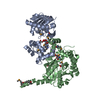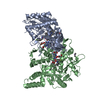[English] 日本語
 Yorodumi
Yorodumi- PDB-4cgz: Crystal structure of the Bloom's syndrome helicase BLM in complex... -
+ Open data
Open data
- Basic information
Basic information
| Entry | Database: PDB / ID: 4cgz | ||||||
|---|---|---|---|---|---|---|---|
| Title | Crystal structure of the Bloom's syndrome helicase BLM in complex with DNA | ||||||
 Components Components |
| ||||||
 Keywords Keywords | HYDROLASE/DNA / HYDROLASE-DNA COMPLEX | ||||||
| Function / homology |  Function and homology information Function and homology informationRecQ family helicase-topoisomerase III complex / forked DNA-dependent helicase activity / resolution of DNA recombination intermediates / telomeric G-quadruplex DNA binding / 8-hydroxy-2'-deoxyguanosine DNA binding / DNA/DNA annealing activity / telomeric D-loop binding / telomere maintenance via semi-conservative replication / DNA geometric change / Y-form DNA binding ...RecQ family helicase-topoisomerase III complex / forked DNA-dependent helicase activity / resolution of DNA recombination intermediates / telomeric G-quadruplex DNA binding / 8-hydroxy-2'-deoxyguanosine DNA binding / DNA/DNA annealing activity / telomeric D-loop binding / telomere maintenance via semi-conservative replication / DNA geometric change / Y-form DNA binding / cellular response to camptothecin / negative regulation of cell division / telomeric D-loop disassembly / t-circle formation / cellular response to hydroxyurea / four-way junction helicase activity / G-quadruplex DNA binding / bubble DNA binding / DNA double-strand break processing / negative regulation of DNA recombination / lateral element / Impaired BRCA2 binding to PALB2 / regulation of cyclin-dependent protein serine/threonine kinase activity / Processive synthesis on the C-strand of the telomere / Homologous DNA Pairing and Strand Exchange / Defective homologous recombination repair (HRR) due to BRCA1 loss of function / Defective HDR through Homologous Recombination Repair (HRR) due to PALB2 loss of BRCA1 binding function / Defective HDR through Homologous Recombination Repair (HRR) due to PALB2 loss of BRCA2/RAD51/RAD51C binding function / Resolution of D-loop Structures through Synthesis-Dependent Strand Annealing (SDSA) / Resolution of D-loop Structures through Holliday Junction Intermediates / DNA 3'-5' helicase / HDR through Single Strand Annealing (SSA) / 3'-5' DNA helicase activity / nuclear chromosome / Impaired BRCA2 binding to RAD51 / mitotic G2 DNA damage checkpoint signaling / protein complex oligomerization / replication fork processing / Presynaptic phase of homologous DNA pairing and strand exchange / response to X-ray / ATP-dependent activity, acting on DNA / SUMOylation of DNA damage response and repair proteins / four-way junction DNA binding / DNA helicase activity / telomere maintenance / replication fork / cellular response to ionizing radiation / helicase activity / double-strand break repair via homologous recombination / protein homooligomerization / G2/M DNA damage checkpoint / PML body / HDR through Homologous Recombination (HRR) / Meiotic recombination / nuclear matrix / p53 binding / single-stranded DNA binding / chromosome / Processing of DNA double-strand break ends / DNA recombination / Regulation of TP53 Activity through Phosphorylation / DNA replication / DNA repair / DNA damage response / positive regulation of DNA-templated transcription / nucleolus / protein homodimerization activity / ATP hydrolysis activity / protein-containing complex / DNA binding / zinc ion binding / nucleoplasm / ATP binding / identical protein binding / nucleus / cytosol / cytoplasm Similarity search - Function | ||||||
| Biological species |  HOMO SAPIENS (human) HOMO SAPIENS (human)SYNTHETIC CONSTRUCT (others) | ||||||
| Method |  X-RAY DIFFRACTION / X-RAY DIFFRACTION /  SYNCHROTRON / SYNCHROTRON /  MOLECULAR REPLACEMENT / Resolution: 3.2 Å MOLECULAR REPLACEMENT / Resolution: 3.2 Å | ||||||
 Authors Authors | Newman, J.A. / Savitsky, P. / Krojer, T. / von Delft, F. / Arrowsmith, C.H. / Edwards, A. / Bountra, C. / Gileadi, O. | ||||||
 Citation Citation |  Journal: Nucleic Acids Res. / Year: 2015 Journal: Nucleic Acids Res. / Year: 2015Title: Crystal Structure of the Bloom'S Syndrome Helicase Indicates a Role for the Hrdc Domain in Conformational Changes. Authors: Newman, J.A. / Savitsky, P. / Allerston, C.K. / Bizard, A.H. / Ozer, O. / Sarlos, K. / Liu, Y. / Pardon, E. / Steyaert, J. / Hickson, I.D. / Gileadi, O. | ||||||
| History |
|
- Structure visualization
Structure visualization
| Structure viewer | Molecule:  Molmil Molmil Jmol/JSmol Jmol/JSmol |
|---|
- Downloads & links
Downloads & links
- Download
Download
| PDBx/mmCIF format |  4cgz.cif.gz 4cgz.cif.gz | 159.3 KB | Display |  PDBx/mmCIF format PDBx/mmCIF format |
|---|---|---|---|---|
| PDB format |  pdb4cgz.ent.gz pdb4cgz.ent.gz | 119.1 KB | Display |  PDB format PDB format |
| PDBx/mmJSON format |  4cgz.json.gz 4cgz.json.gz | Tree view |  PDBx/mmJSON format PDBx/mmJSON format | |
| Others |  Other downloads Other downloads |
-Validation report
| Summary document |  4cgz_validation.pdf.gz 4cgz_validation.pdf.gz | 715.1 KB | Display |  wwPDB validaton report wwPDB validaton report |
|---|---|---|---|---|
| Full document |  4cgz_full_validation.pdf.gz 4cgz_full_validation.pdf.gz | 727.3 KB | Display | |
| Data in XML |  4cgz_validation.xml.gz 4cgz_validation.xml.gz | 25 KB | Display | |
| Data in CIF |  4cgz_validation.cif.gz 4cgz_validation.cif.gz | 33.6 KB | Display | |
| Arichive directory |  https://data.pdbj.org/pub/pdb/validation_reports/cg/4cgz https://data.pdbj.org/pub/pdb/validation_reports/cg/4cgz ftp://data.pdbj.org/pub/pdb/validation_reports/cg/4cgz ftp://data.pdbj.org/pub/pdb/validation_reports/cg/4cgz | HTTPS FTP |
-Related structure data
| Related structure data |  4cdgSC S: Starting model for refinement C: citing same article ( |
|---|---|
| Similar structure data |
- Links
Links
- Assembly
Assembly
| Deposited unit | 
| ||||||||
|---|---|---|---|---|---|---|---|---|---|
| 1 |
| ||||||||
| Unit cell |
|
- Components
Components
| #1: Protein | Mass: 75692.094 Da / Num. of mol.: 1 / Fragment: CATALYTIC CORE, RESIDUES 636-1298 Source method: isolated from a genetically manipulated source Source: (gene. exp.)  HOMO SAPIENS (human) / Production host: HOMO SAPIENS (human) / Production host:  |
|---|---|
| #2: DNA chain | Mass: 3687.417 Da / Num. of mol.: 1 / Source method: obtained synthetically / Source: (synth.) SYNTHETIC CONSTRUCT (others) |
| #3: DNA chain | Mass: 5099.298 Da / Num. of mol.: 1 / Source method: obtained synthetically / Source: (synth.) SYNTHETIC CONSTRUCT (others) |
| #4: Chemical | ChemComp-ZN / |
| #5: Chemical | ChemComp-ADP / |
| Sequence details | FIRST 2 RESIDUES REMAIN FOLLOWING CLEAVAGE OF PURIFICATI |
-Experimental details
-Experiment
| Experiment | Method:  X-RAY DIFFRACTION / Number of used crystals: 1 X-RAY DIFFRACTION / Number of used crystals: 1 |
|---|
- Sample preparation
Sample preparation
| Crystal | Density Matthews: 4.19 Å3/Da / Density % sol: 80 % / Description: NONE |
|---|---|
| Crystal grow | Details: 21% PEG 4000, 0.1M HEPES PH 7.6, 5% 2-PROPANOL |
-Data collection
| Diffraction | Mean temperature: 100 K |
|---|---|
| Diffraction source | Source:  SYNCHROTRON / Site: SYNCHROTRON / Site:  Diamond Diamond  / Beamline: I24 / Wavelength: 0.9686 / Beamline: I24 / Wavelength: 0.9686 |
| Detector | Type: DECTRIS PILATUS 6M / Detector: PIXEL / Date: Sep 16, 2013 |
| Radiation | Protocol: SINGLE WAVELENGTH / Monochromatic (M) / Laue (L): M / Scattering type: x-ray |
| Radiation wavelength | Wavelength: 0.9686 Å / Relative weight: 1 |
| Reflection | Resolution: 3.2→48.68 Å / Num. obs: 23593 / % possible obs: 99.5 % / Observed criterion σ(I): -3 / Redundancy: 3.4 % / Biso Wilson estimate: 146.81 Å2 / Rmerge(I) obs: 0.04 / Net I/σ(I): 11.9 |
| Reflection shell | Resolution: 3.2→3.42 Å / Redundancy: 3.4 % / Rmerge(I) obs: 1.5 / Mean I/σ(I) obs: 0.6 / % possible all: 99.7 |
- Processing
Processing
| Software |
| |||||||||||||||||||||||||||||||||||||||||||||||||||||||||||||||||||||||||||||||||||||||||||||||||||||||||||||||||||||||
|---|---|---|---|---|---|---|---|---|---|---|---|---|---|---|---|---|---|---|---|---|---|---|---|---|---|---|---|---|---|---|---|---|---|---|---|---|---|---|---|---|---|---|---|---|---|---|---|---|---|---|---|---|---|---|---|---|---|---|---|---|---|---|---|---|---|---|---|---|---|---|---|---|---|---|---|---|---|---|---|---|---|---|---|---|---|---|---|---|---|---|---|---|---|---|---|---|---|---|---|---|---|---|---|---|---|---|---|---|---|---|---|---|---|---|---|---|---|---|---|---|
| Refinement | Method to determine structure:  MOLECULAR REPLACEMENT MOLECULAR REPLACEMENTStarting model: PDB ENTRY 4CDG Resolution: 3.2→48.646 Å / SU ML: 0.47 / σ(F): 0.22 / Phase error: 33.26 / Stereochemistry target values: ML
| |||||||||||||||||||||||||||||||||||||||||||||||||||||||||||||||||||||||||||||||||||||||||||||||||||||||||||||||||||||||
| Solvent computation | Shrinkage radii: 0.9 Å / VDW probe radii: 1.11 Å / Solvent model: FLAT BULK SOLVENT MODEL | |||||||||||||||||||||||||||||||||||||||||||||||||||||||||||||||||||||||||||||||||||||||||||||||||||||||||||||||||||||||
| Displacement parameters | Biso mean: 178 Å2 | |||||||||||||||||||||||||||||||||||||||||||||||||||||||||||||||||||||||||||||||||||||||||||||||||||||||||||||||||||||||
| Refinement step | Cycle: LAST / Resolution: 3.2→48.646 Å
| |||||||||||||||||||||||||||||||||||||||||||||||||||||||||||||||||||||||||||||||||||||||||||||||||||||||||||||||||||||||
| Refine LS restraints |
| |||||||||||||||||||||||||||||||||||||||||||||||||||||||||||||||||||||||||||||||||||||||||||||||||||||||||||||||||||||||
| LS refinement shell |
|
 Movie
Movie Controller
Controller










 PDBj
PDBj












































